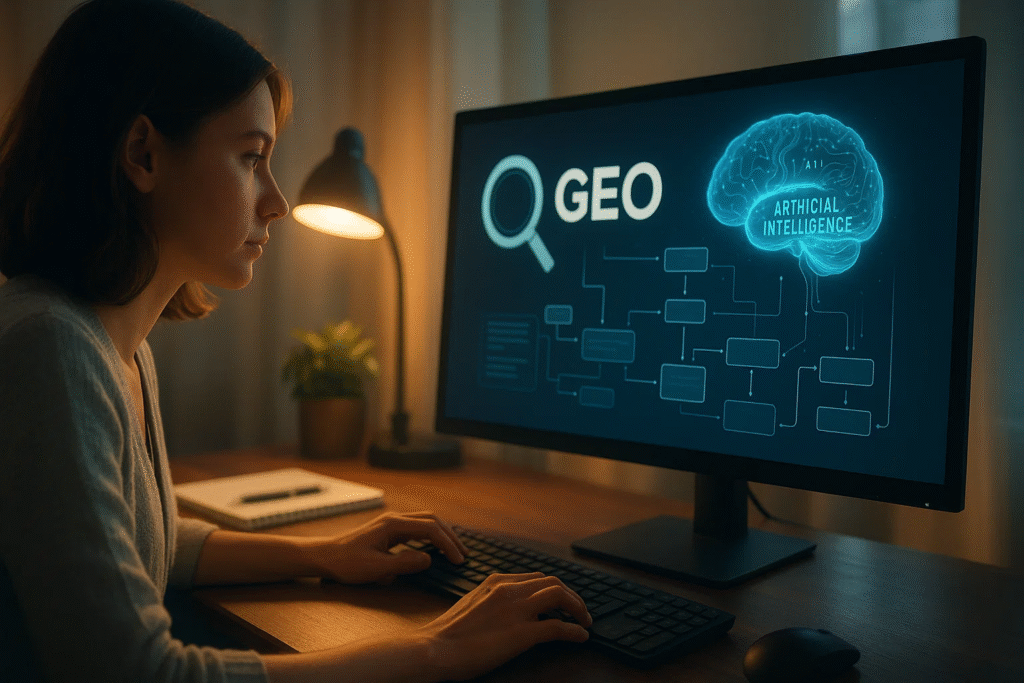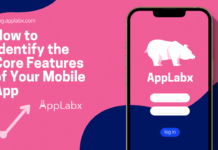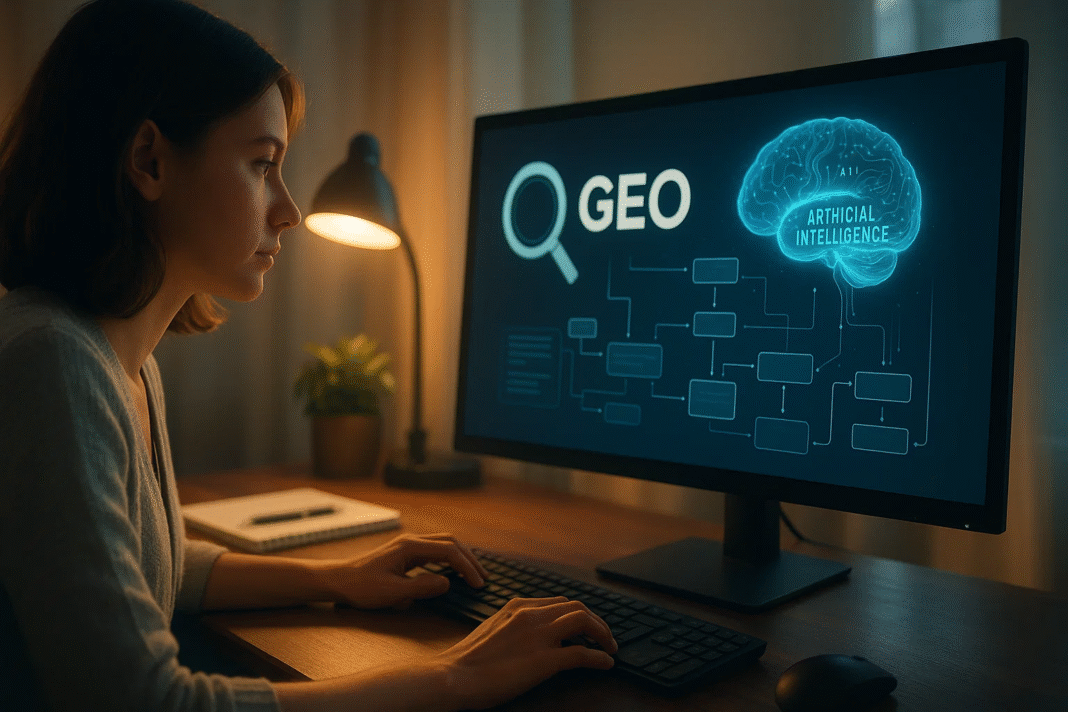Key Takeaways
- Generative Engine Optimization (GEO) focuses on optimizing content for AI-powered search engines like ChatGPT, Google SGE, and Perplexity AI.
- GEO prioritizes structured data, semantic clarity, and authoritative citations over traditional keyword rankings.
- Implementing GEO strategies boosts AI visibility, brand authority, and performance in zero-click, generative search environments.
As artificial intelligence continues to revolutionize how we access and interact with information online, a transformative shift is unfolding in the world of search. Traditional Search Engine Optimization (SEO), which has long been the cornerstone of digital visibility, is now being reshaped by the emergence of generative AI technologies. This evolution has given rise to a new frontier in digital marketing—Generative Engine Optimization (GEO).

Generative Engine Optimization refers to the process of optimizing content specifically for AI-driven search platforms, such as Google’s Search Generative Experience (SGE), ChatGPT, Perplexity AI, Bing Copilot, and other large language model (LLM)-based tools. Unlike conventional SEO, which primarily aims to rank content in search engine result pages (SERPs), GEO is designed to increase the likelihood that content will be cited, referenced, or summarized directly by AI-powered engines in response to user queries. In an era where users increasingly prefer conversational and instant answers, GEO is quickly becoming a critical strategy for brands, publishers, and marketers aiming to stay visible in a changing search ecosystem.
The core difference between traditional SEO and GEO lies in the search experience itself. While classic SEO targets a keyword-to-page ranking model, GEO focuses on intent, context, credibility, and structure—elements that AI systems prioritize when selecting content for generative outputs. Generative engines do not simply list websites; they synthesize and respond using real-time data, trusted content, and authoritative sources. As a result, GEO requires content creators to optimize not just for crawlers and algorithms but for AI understanding, summarization, and citation.
Why is this shift so important? Because the search behavior of users is evolving rapidly. Generative engines provide answers in the form of zero-click results, often eliminating the need to visit a website. In these cases, only the most credible, well-structured, and informative content is cited by the AI—meaning that unless your content is specifically optimized for this new environment, it risks being overlooked entirely. GEO ensures that your content remains competitive and discoverable in these AI-driven interfaces.
Moreover, the emergence of GEO reflects broader digital trends in 2025. As LLMs become integral to both search and consumer decision-making processes, brands are recognizing that visibility in generative answers is the next battleground. GEO is not just a trend—it’s a paradigm shift. It combines technical optimization, content strategy, semantic structuring, and authority building in a unified framework tailored for the future of AI-first search.
This blog will provide a comprehensive guide to understanding what Generative Engine Optimization is, how it works, how it differs from traditional SEO, and what practical strategies you can implement to succeed in this emerging landscape. Whether you’re a digital marketer, SEO specialist, content strategist, or business owner, this guide will help you understand how to future-proof your online presence and adapt to the next generation of search technology.
But, before we venture further, we like to share who we are and what we do.
About AppLabx
From developing a solid marketing plan to creating compelling content, optimizing for search engines, leveraging social media, and utilizing paid advertising, AppLabx offers a comprehensive suite of digital marketing services designed to drive growth and profitability for your business.
At AppLabx, we understand that no two businesses are alike. That’s why we take a personalized approach to every project, working closely with our clients to understand their unique needs and goals, and developing customized strategies to help them achieve success.
If you need a digital consultation, then send in an inquiry here.
What is Generative Engine Optimization (GEO) and How It Works
- Introduction to Generative Engine Optimization (GEO)
- The Rise of Generative Search Engines
- What is GEO: Core Concept Explained
- How GEO Works: Key Components
- GEO vs Traditional SEO: A Comparative Table
- Benefits of Implementing GEO
- GEO Strategies for 2025 and Beyond
- Tools and Platforms Supporting GEO
- Challenges and Considerations
- Future of GEO in Search Marketing
1. Introduction to Generative Engine Optimization (GEO)
Generative Engine Optimization (GEO) is emerging as a revolutionary approach to search visibility in the age of AI-powered, conversational search platforms. Unlike traditional SEO, which is centered around optimizing for search engine result pages (SERPs), GEO is tailored to improve a brand’s visibility within the responses of large language models (LLMs) and generative engines like ChatGPT, Perplexity AI, Google’s SGE, and Bing Copilot.
This section explores the concept of GEO, its importance in modern search behavior, and how it fits into the evolving digital landscape of 2025 and beyond.
What is Generative Engine Optimization (GEO)?
Definition and Core Objective
- GEO stands for Generative Engine Optimization
- It is the practice of structuring and optimizing content so that generative AI engines can understand, cite, summarize, or directly extract from it
- Focuses on visibility within AI responses, not just traditional rankings
Where GEO Applies
- Chatbots and AI assistants (e.g., ChatGPT, Claude, Gemini)
- Search Generative Experience (SGE) on Google
- Answer engines like Perplexity AI, You.com, NeevaAI
- Voice assistants and voice-activated AI tools (e.g., Alexa, Siri with AI enhancements)
Why GEO Matters in 2025
Key Trends Driving GEO
- Zero-click search growth: Users receive answers without clicking on a search result
- Rise of AI-first discovery: People increasingly use tools like ChatGPT for research, decision-making, and purchases
- Reduced reliance on traditional search engines: AI tools act as gatekeepers to knowledge, changing visibility dynamics
- Higher expectations for contextual, expert-driven content
Impacts on Businesses and Marketers
- Traditional SEO visibility is no longer sufficient
- Brands must adapt to AI citation logic
- Content must be structured to be understood and trusted by LLMs
Real-World Examples of GEO in Action
| Platform | GEO in Practice |
|---|---|
| ChatGPT (Browse) | Cites content from trusted blogs or studies in answers |
| Google SGE | Pulls sections of content from web pages and shows summaries |
| Perplexity AI | Directly cites and links sources, giving exposure to well-structured, authoritative content |
| Bing Copilot | Summarizes content from multiple sites and credits top sources |
How GEO Differs from Traditional SEO
| Factor | Traditional SEO | Generative Engine Optimization (GEO) |
|---|---|---|
| Objective | Rank in SERPs | Be cited or summarized in AI-generated output |
| Search Format | 10 blue links | AI-powered answers and summaries |
| User Journey | Click-based | Answer-based |
| Optimization Targets | Search engine algorithms (Google, Bing) | AI models (ChatGPT, SGE, Perplexity) |
| Content Style | Keyword-rich, long-form | Fact-based, structured, semantically rich |
| Success Metric | Rank position, organic traffic | Citation frequency, brand mention in AI |
| Technical Elements | Meta tags, backlinks, keyword density | Data accuracy, source trust, semantic clarity |
Pillars of Effective GEO Strategy
1. Structured, Citation-Friendly Content
- Use clear headers (H2, H3) and concise language
- Include verified statistics, quotes, and facts
- Ensure content is well-sourced and attributed
2. High Authoritativeness (E-E-A-T)
- Focus on Experience, Expertise, Authoritativeness, Trustworthiness
- Use author bios with links to LinkedIn or academic profiles
- Mention relevant credentials and real-world experience
3. Contextual and Semantic Optimization
- Use entities, not just keywords (e.g., “Elon Musk” instead of just “CEO”)
- Write with contextual clarity for AI understanding
- Use FAQ-style formats to encourage AI summarization
4. Conversational Relevance
- Content must sound natural and informative
- Use Q&A sections, bullet points, and numbered lists
- Avoid jargon unless your target audience expects it
5. Technical Best Practices
- Implement schema markup (e.g., FAQPage, Article, Person)
- Improve page speed, UX, and mobile-first design
- Optimize for crawlability and data precision
GEO Success Matrix
| Attribute | Low GEO Potential | High GEO Potential |
|---|---|---|
| Content Style | Dense, keyword-stuffed text | Structured, factual, easy-to-parse |
| Authorship | Anonymous or unclear | Clear, expert authorship with E-E-A-T signals |
| Linking and Citations | No external sources | Verified references, studies, external data |
| Entity Use | Vague/general terminology | Specific names, places, statistics, organizations |
| AI-Friendliness | Jargon, complex sentences | Clear, conversational, Q&A or explainer format |
Final Takeaway: Why You Should Care About GEO
- GEO is not a replacement for SEO, but a powerful extension
- As more users interact with AI-driven search and discovery tools, traditional rankings may become secondary
- GEO positions your brand at the forefront of AI search visibility, making it a crucial strategy for the next phase of digital content marketing
2. The Rise of Generative Search Engines
The evolution of search has entered a new era driven by generative AI, where traditional search engine result pages (SERPs) are being augmented—or in some cases replaced—by AI-generated responses. This marks a fundamental change in how users discover, consume, and interact with online information. Unlike classic search engines that list links, generative search engines synthesize content in real-time, delivering conversational, contextual, and concise answers.
This section explores the rise of generative search engines, the key players shaping this space, changing user behaviors, and the broader implications for SEO and content strategy.
What Are Generative Search Engines?
Core Characteristics
- Built on large language models (LLMs) such as GPT-4, Gemini, or Claude
- Return AI-generated answers, not just ranked links
- Designed to provide conversational, context-aware results
- Often combine real-time browsing with LLM output
Key Functionalities
- Summarizing content from multiple sources
- Responding to natural language queries
- Engaging users in dialogue-style search
- Offering citations to sources when available
Top Generative Search Engines in 2025
| Engine | Developer | Key Features | Use Case Example |
|---|---|---|---|
| ChatGPT (Browse) | OpenAI | Conversational answers with live browsing, plugins, and tools | Researching product comparisons or trends |
| Google SGE | Integrated AI answers into the SERP, source links included | Getting AI summaries on top of Google results | |
| Perplexity AI | Perplexity.ai | Real-time web results with citations and follow-up suggestions | Academic-style fact-finding or quick news |
| Bing Copilot | Microsoft | Chat and search combined with links to sources and images | Summarizing multiple perspectives from web |
| You.com | You.com | Privacy-focused generative search with source control | Finding summarized info with filter options |
Why Are Generative Search Engines Gaining Popularity?
1. Shift in User Expectations
- Users want instant, accurate answers—not long browsing sessions
- Conversational queries are replacing keyword-heavy inputs
- Mobile and voice-first interfaces demand quick summarization
2. Enhanced Productivity
- One query yields actionable, synthesized results
- Useful for busy professionals, students, and researchers
- Eliminates need to open and compare multiple pages
3. Trust and Source Transparency
- Engines like Perplexity show inline citations
- Users gain confidence when answers link to authoritative sources
4. Personalization and Interaction
- Tools like ChatGPT allow follow-up prompts for deeper exploration
- Generative search adapts to user context and history
Comparing Generative and Traditional Search Engines
| Feature | Traditional Search Engine | Generative Search Engine |
|---|---|---|
| Results Format | List of links (SERPs) | AI-generated summary with citations |
| Query Type | Short, keyword-based | Conversational, intent-driven |
| Time to Insight | Requires link clicking | Immediate, in-surface answers |
| Content Discovery | Dependent on rankings | Synthesized from multiple pages |
| User Interaction | One-time query | Interactive and iterative |
| Ranking Factors | Links, authority, on-page SEO | Authority, clarity, factual precision |
| AI Integration | Minimal to moderate | Core function |
User Behavior Trends Driving Generative Search
Natural Language Search on the Rise
- More users search with full sentences or questions (e.g., “What is the best alternative to Google Analytics?”)
- LLMs handle semantic and contextual nuance better than traditional algorithms
Increasing Use of AI Assistants
- Millions of users now rely on ChatGPT, Gemini, or Copilot for day-to-day tasks
- Younger users are shifting from search engines to AI-first discovery methods
Zero-Click Search Becomes Norm
- Many users do not scroll or click beyond the AI answer box
- Google’s SGE, for instance, captures user attention above the fold, reducing clicks to websites
Case Study: Perplexity AI’s Growth
- Perplexity AI saw explosive growth in 2024–2025 due to:
- Real-time citation of reliable sources
- Mobile-friendly experience
- Follow-up query threading
- Frequently used for homework help, tech reviews, and financial summaries
GEO Relevance in the Generative Era
| User Behavior Shift | GEO Response |
|---|---|
| Conversational queries | Structure content in natural Q&A formats |
| AI summarization preference | Write with clarity and factual density |
| Trust in cited sources | Strengthen author bios and source credibility |
| Mobile and voice-first usage | Keep language accessible and formats scannable |
The Generative Search Engine Landscape: Ecosystem Map
+---------------------------+
| Traditional Search Layer |
| (Google, Bing, etc.) |
+---------------------------+
|
v
+---------------------------+
| Generative AI Layer |
| (SGE, Perplexity, GPT) |
+---------------------------+
|
v
+---------------------------+
| User Experience Layer |
| (Answers, Summaries, Chat)|
+---------------------------+
Future Outlook: What Comes Next?
1. AI-First Browsers
- Browsers like Arc and Brave AI are integrating generative responses by default
- Search becomes an assistant experience, not a list of links
2. Monetization Shifts
- Fewer ad clicks as users don’t visit external sites
- SEO metrics like CTR and impressions may become secondary to AI citation visibility
3. Generative Commerce Search
- Platforms like Amazon and Shopify exploring AI-driven product discovery
- GEO will extend into ecommerce content and listings
Conclusion: Embracing the Shift
The rise of generative search engines marks a profound disruption in how digital information is created, surfaced, and consumed. Businesses, content creators, and SEO professionals must realign their strategies toward visibility in AI responses, not just traditional rankings. Generative Engine Optimization is the toolset that allows brands to adapt and thrive in this emerging paradigm.
3. What is GEO: Core Concept Explained
As generative AI becomes an integral part of search and digital discovery, a new discipline has emerged: Generative Engine Optimization (GEO). GEO is the structured, strategic process of optimizing content for AI-powered engines—not just traditional search engines like Google or Bing. It focuses on ensuring that content is understood, cited, and used by AI models like ChatGPT, Perplexity AI, Google SGE, and others in their generated answers.
This section provides a comprehensive breakdown of the GEO concept, how it works at a technical and strategic level, and what sets it apart from legacy SEO practices.
Definition of GEO
Core Meaning
- GEO stands for Generative Engine Optimization
- It’s the process of making your content AI-readable, AI-trustworthy, and AI-citable
- It aims to increase the chances of being referenced or summarized by LLMs during user interactions
Purpose
- Boost visibility in AI-generated results rather than traditional SERP listings
- Align content with AI content selection logic, such as contextual relevance and factual accuracy
How GEO Works at a High Level
Step-by-Step Process
- Intent Modeling
- Understand how users phrase questions in natural language
- Predict AI interpretations of those queries
- Content Structuring
- Use semantic HTML (e.g., H2, H3, FAQ blocks)
- Add schema markup (e.g., Article, FAQPage, Author)
- Authority and Clarity
- Cite data from authoritative sources
- Establish clear authorship and credentials
- AI-Friendliness
- Write in Q&A or explainer formats
- Use entities and synonyms to support NLP comprehension
- Distribution and Presence
- Get indexed by platforms like Perplexity, ChatGPT Browse, and SGE
- Optimize for inclusion in AI memory or browsing datasets
Key Principles Behind GEO
1. Optimization for Large Language Models (LLMs)
- LLMs prefer structured, trustworthy, and semantically rich content
- GEO content must:
- Be easy to parse
- Contain entities and clear intent
- Be aligned with factual precision
2. Structured Data Matters More Than Ever
- Use of schema.org markup is critical
- Include:
- Author
- Publication date
- Fact-based content blocks
- FAQ markup
3. Citation-Ready Content
- LLMs like Perplexity and ChatGPT Browse prioritize:
- Authoritative websites
- Pages with verifiable, factual claims
- Well-organized content with clear titles, summaries, and lists
Example: How GEO Looks in Practice
Traditional SEO Content Example:
“The best productivity tools in 2025 include Notion, Trello, and Asana.”
GEO-Optimized Version:
“According to a 2025 survey by ProductiveTech, the top-rated productivity platforms are:
- Notion – for integrated notes, tasks, and databases
- Trello – for visual Kanban project management
- Asana – for advanced task delegation and team workflows
Source: [ProductiveTech Annual Report 2025]”
Why the GEO Version Works:
- Structured list
- Factual claim with citation
- Rich context for AI summarization
GEO Optimization Priorities Matrix
| GEO Element | Importance | Description |
|---|---|---|
| Entity Clarity | High | Use named people, companies, locations, and topics clearly |
| Source Credibility | High | Reference peer-reviewed, industry, or official data |
| Q&A Format | Medium | Boosts clarity for AI understanding |
| Schema Markup | High | Supports better parsing by AI crawlers |
| Conversational Tone | Medium | Helps fit user-friendly, AI-generated answers |
| Backlink Profile | Low | Less relevant for GEO than traditional SEO |
GEO vs Traditional SEO: Functional Comparison
| Feature | Traditional SEO Focus | GEO Focus |
|---|---|---|
| Ranking Goal | Page 1 of SERP | Cited/summarized in AI answers |
| Primary Target | Search engine bots | AI models and generative engines |
| Content Format | Long-form, keyword-rich | Structured, factual, conversational |
| Content Value Signal | Backlinks and domain authority | Authority, clarity, and citation-worthiness |
| Success Metrics | CTR, impressions, rankings | AI citation frequency, visibility in outputs |
| Optimization Tools | Ahrefs, Semrush, Google Search Console | SGE Insights, Perplexity Pages, ChatGPT plug-ins |
AI Citation Funnel: From Content Creation to Visibility
+---------------------+
| Content Creation |
+---------------------+
|
v
+---------------------+
| Semantic Structuring|
+---------------------+
|
v
+---------------------+
| Schema Markup |
+---------------------+
|
v
+---------------------+
| AI Content Parsing|
+---------------------+
|
v
+---------------------+
| Citation in AI UX |
+---------------------+
Tools That Support GEO
| Tool/Platform | Use Case |
|---|---|
| Perplexity Pages | Publishing citation-friendly expert content |
| SGE Labs (Google) | Testing how Google’s AI parses and summarizes data |
| ChatGPT Browse | Validating citation visibility in AI outputs |
| Schema Markup Generator | Adds structured data for easier AI parsing |
| Originality.ai | Ensures factual accuracy in AI-friendly content |
Conclusion: GEO as the New Frontier of Search Optimization
GEO represents a profound shift in content strategy—one where visibility is no longer determined by position in a list, but by inclusion in AI-generated answers. For digital marketers and SEO professionals, this means adapting to a new set of signals and priorities that focus on clarity, factual depth, structure, and authoritativeness. The more accessible your content is to AI models, the higher your chances of being cited, mentioned, and trusted in the generative era of search.
4. How GEO Works: Key Components
Generative Engine Optimization (GEO) functions at the intersection of content clarity, AI comprehension, and search intent. Its primary objective is to ensure that your content is easily discoverable, interpretable, and reusable by generative AI tools like ChatGPT, Google SGE, Perplexity AI, and Bing Copilot.
This section breaks down the core components of how GEO works, offering a detailed look at the mechanics that increase the chances of your content being cited or surfaced in AI-generated answers. Understanding these elements is critical to succeeding in a generative search environment.
1. Semantic and Intent-Based Optimization
Understanding User Intent
- Focus on natural language questions, not just keywords
- Align content with query types like:
- “What is…” (definition-based)
- “How to…” (instructional)
- “Best tools for…” (comparative)
Use of Semantic Keywords and Entities
- Go beyond simple keywords by incorporating related entities and synonyms
- Example: Use “Google’s SGE” instead of repeating “AI search engine”
- Tools to extract semantic entities:
- Google NLP API
- OpenAI embeddings
- Surfer SEO
Best Practices
- Answer one intent per section
- Include variations of the query phrased naturally
- Maintain consistency in topic and terminology
2. Optimizing for AI Citations and Summaries
Making Your Content Citation-Friendly
- Ensure factual accuracy and include source attribution
- Use specific statistics, named studies, or expert quotes
- Example: “According to Deloitte’s 2025 AI Trends Report, 76% of enterprises are now using LLMs.”
- Insert contextual data to support claims
Elements AI Looks for in Citations
- Short, well-structured paragraphs
- Lists, bullet points, and FAQs
- Use of schema markup to highlight key content areas
Sample Citation-Ready Format
Top Generative Search Tools in 2025:
- ChatGPT with Browsing
- Perplexity AI
- Google’s SGE
- Bing Copilot
Source: AI Discovery Trends 2025 Report
3. Structured Data and Schema Markup
Importance for AI Parsing
- Schema helps AI engines extract context and purpose
- Markup like
FAQPage,Article,Author, andHowToincreases visibility
Recommended Schema Types for GEO
| Schema Type | Usage Scenario | AI Benefit |
|---|---|---|
FAQPage | For Q&A sections | Easier citation for LLMs |
Article | For blog posts and editorial content | Helps establish topical relevance |
HowTo | For instructional content | Enables AI to break down step-by-step |
Person | For author profiles | Boosts E-E-A-T signals |
Implementation Tools
- RankMath or Yoast (WordPress)
- Merkle’s Schema Markup Generator
- Google’s Structured Data Markup Helper
4. Conversational Content Formatting
Mimic LLM Output Style
- Write in a tone and structure that matches how LLMs respond:
- Short sentences
- Direct, factual answers
- Summaries followed by breakdowns
Include Frequently Asked Questions (FAQs)
- Helps AI understand multiple intents per topic
- Structure example: markdownCopyEdit
### What is GEO? GEO, or Generative Engine Optimization, is the process of making content optimized for AI engines like ChatGPT or Perplexity AI.
Content Format Table
| Content Element | Benefit to GEO |
|---|---|
| Bullet points | Easy for AI to extract and summarize |
| Numbered lists | Supports step-by-step responses |
| Clear headings (H2/H3) | Aids LLM parsing and structure |
| Short paragraphs | Improves comprehension and scanability |
| Quote blocks | Adds source credibility |
5. Author Identity and Source Credibility
Establishing Trust Signals
- AI engines prioritize trustworthy content
- Ensure:
- Author is named with bio and credentials
- Links to professional networks (LinkedIn, personal site)
- Domain has a history of publishing accurate information
E-E-A-T in the GEO Context
| Element | GEO Strategy |
|---|---|
| Experience | Real-world examples, case studies |
| Expertise | Verified authorship with industry background |
| Authority | Mentions by other respected domains |
| Trustworthiness | Transparent sourcing and up-to-date content |
6. Page Experience and Technical Structure
GEO Still Relies on SEO Foundations
- Core Web Vitals remain important:
- Load speed
- Mobile responsiveness
- Interaction readiness
Mobile and Voice Optimization
- AI engines are often accessed through mobile or smart devices
- Ensure:
- Readable font size
- Clean, responsive layouts
- Logical navigation hierarchy
Technical Checklist
| Technical Factor | Importance to GEO | Implementation Tools |
|---|---|---|
| Page speed | High | PageSpeed Insights |
| Mobile usability | High | Google Mobile-Friendly Test |
| Internal linking | Medium | Screaming Frog |
| Headings and layout | High | HTML5 Outline, Hemingway |
| Crawlability | Medium | Google Search Console |
7. Real-World GEO Implementation Examples
| Website/Platform | GEO Tactic Used | Result |
|---|---|---|
| Perplexity AI | Uses bullet lists from source blogs in answers | Increases exposure for structured content |
| SGE Results (Google) | Cites content from schema-marked blog articles | Shows brand in AI snapshot box |
| ChatGPT Browse | Summarizes expert blogs with named authors | Highlights factual blogs in conversation |
| Healthline | Uses strong author bios and source citations | Frequently quoted by AI models |
8. GEO Readiness Scorecard
| Content Attribute | Score Weight | Optimized Example | Weak Example |
|---|---|---|---|
| Author & Source Credibility | 25% | “Written by Dr. Lisa Tran, PhD in AI Systems” | No author listed |
| Structured Formatting | 20% | Headers, bullets, short paragraphs | Wall of text |
| Schema Markup Implementation | 15% | FAQPage and Article structured data | None |
| Factual Depth and Citations | 20% | Includes data and external studies | Unsupported opinions |
| Entity & Semantic Coverage | 10% | Uses proper names and terminology | Generic descriptors |
| Conversational Clarity | 10% | Reads like an AI response | Overly technical or abstract |
Conclusion: Building GEO from the Ground Up
GEO is a multi-layered optimization strategy that blends elements of traditional SEO, content strategy, AI literacy, and semantic architecture. Its success depends not only on keywords or links but on your content’s readability, trustworthiness, and structural integrity—as interpreted by large language models. By mastering these core components, brands can build an authoritative digital footprint in the AI-first era of search.
5. GEO vs Traditional SEO: A Comparative Table
As the digital search landscape evolves, content marketers and SEO professionals must adapt to the rise of Generative Engine Optimization (GEO). While traditional SEO is focused on ranking web pages in search engine results pages (SERPs), GEO is designed to improve content visibility within AI-generated responses from platforms like ChatGPT, Google SGE, Bing Copilot, and Perplexity AI.
This section provides a comprehensive side-by-side comparison of GEO and traditional SEO, highlighting the core differences in strategy, output, optimization focus, and performance metrics. It includes tables, real-world examples, and implementation insights to help you understand how each approach aligns with the evolving search experience in 2025 and beyond.
1. Core Objectives and Use Cases
Primary Goal Comparison
| Factor | Traditional SEO | Generative Engine Optimization (GEO) |
|---|---|---|
| Goal | Rank content on the first page of SERPs | Be cited, summarized, or used in AI responses |
| Search Model | Keyword and backlink-driven ranking algorithm | Intent and context-driven AI reasoning |
| Target Engine | Google, Bing, Yahoo | ChatGPT, Google SGE, Perplexity, Bing Copilot |
| Primary Metric | Clicks, impressions, keyword position | AI citations, summary inclusions, zero-click mentions |
| User Interaction | Click and read through website | Receive instant answers with cited content |
2. Content Structure and Formatting
How AI and Search Engines Process Content
| Aspect | Traditional SEO | GEO |
|---|---|---|
| Content Structure | Long-form, keyword-dense, optimized headers | Short-form, bullet points, Q&A, FAQs |
| Language Style | Keyword-oriented, promotional tone | Informational, conversational, factual |
| Entity Usage | Optional, often vague or general | Mandatory—specific names, dates, data |
| Content Depth | Focused on dwell time and engagement | Focused on clarity and machine readability |
| Voice Optimization | Rarely prioritized | Highly important (many LLM queries are voice-initiated) |
Example Breakdown
| Query | Traditional SEO Output | GEO Output |
|---|---|---|
| “Best SEO agencies in Berlin” | Listicle blog with 1000+ words, optimized H2s | Summary: “Top SEO agencies include Omnius, HVSEO, and Searchtide.” |
| “How does GEO work?” | Blog post with internal links and CTAs | Direct answer: “GEO is a method to structure content for LLMs to cite in AI-generated answers.” |
3. Technical SEO vs AI-Readiness
Foundational Optimization Differences
| Technical Area | Traditional SEO | GEO Optimization |
|---|---|---|
| Schema Markup | Used for SERP enhancements (stars, FAQs) | Used for AI parsing (Article, FAQPage, Author) |
| Sitemaps & Crawling | Essential for indexability | Important, but secondary to structured content |
| Mobile UX | Required by search algorithms | Important for AI surface rendering |
| Page Speed & Core Web Vitals | Critical ranking signals | Baseline requirement, not a differentiator |
| Alt Text & ARIA | Optional for accessibility | Enhances AI comprehension in image citations |
4. Measurement Metrics and KPIs
How Success Is Measured
| Performance Metric | Traditional SEO | GEO |
|---|---|---|
| Organic Traffic | Primary metric (measured via Google Analytics) | Secondary to citation appearance |
| Keyword Ranking | Central focus | Less relevant due to zero-click environments |
| Click-Through Rate (CTR) | Essential for optimization | Often irrelevant; users don’t need to click |
| Citation Frequency | Not measured | Critical metric in tools like Perplexity Pages or SGE Labs |
| Visibility in AI Responses | Not tracked | Primary success indicator |
5. Search Interface and User Experience
How Users Engage with Content
| Component | Traditional SEO | GEO |
|---|---|---|
| User Journey | Query → SERP → Click → Read → Convert | Query → AI Answer → Citation or Summary |
| Information Delivery | Multiple options across 10 blue links | One synthesized, AI-generated response |
| User Attention Span | Longer sessions (3–5 min) | Short interactions (under 1 min) |
| Preferred Format | Articles, blogs, product pages | Bulleted summaries, answer boxes, concise facts |
Search Experience Matrix
| Query Type | Traditional SEO Outcome | GEO Outcome |
|---|---|---|
| “Top CRM tools 2025” | Blog post with comparisons and screenshots | Summary list with 2–3 top tools + citations |
| “What is Perplexity AI?” | 800-word explainer blog | Two-sentence summary pulled from source |
| “GEO vs SEO differences” | Long-form blog | Inline comparison table shown in result |
6. Tools and Platforms
Tech Stack Alignment for Each Strategy
| Category | Traditional SEO Tools | GEO-Focused Tools |
|---|---|---|
| Keyword Research | Semrush, Ahrefs, Ubersuggest | AlsoAsked, AnswerThePublic, ChatGPT Insights |
| On-Page SEO | Surfer SEO, Clearscope | Content Harmony (GEO adaptation), Frase |
| Structured Data | Merkle Schema Generator, Yoast, RankMath | ChatGPT Plugin schema generators, JSON-LD tools |
| Performance Tracking | Google Search Console, GA4 | Perplexity Page Insights, SGE Labs Console |
7. Long-Term Strategy and Business Goals
How Each Method Serves Brand Growth
| Business Impact | Traditional SEO | GEO |
|---|---|---|
| Brand Discovery | Via organic search rankings | Via AI recommendations and citations |
| Thought Leadership | Gained through backlinks and content shares | Gained through inclusion in expert summaries |
| Traffic Generation | Primary focus of strategy | Secondary—visibility prioritized over traffic |
| Revenue Attribution | Easier to attribute clicks and conversions | Harder to track unless linked from AI interfaces |
| Platform Dependency | Google-centric | Distributed across many AI tools and LLMs |
8. Strategic Alignment Summary Chart
| SEO Element | Traditional SEO | GEO | Recommended Use Case |
|---|---|---|---|
| Keyword Rankings | Core metric | Less relevant | Traditional blogs, ecommerce listings |
| Structured Data | Optional | Essential | All long-form and factual content |
| FAQ Sections | Enhances SERP | Enables AI understanding | Product pages, educational blogs |
| Author Profiles | Helpful | Crucial (E-E-A-T signal) | Health, finance, legal content |
| External Citations | Often missing | Required | Statistics-based articles |
| Bullet & List Formatting | Good for UX | Critical for AI parsing | Lists, comparisons, tool roundups |
| Conversational Tone | Optional | Highly recommended | Informational and how-to content |
Conclusion: Choosing the Right Strategy in the AI Era
GEO and traditional SEO are not mutually exclusive, but serve different roles within the evolving search ecosystem. Traditional SEO remains vital for ranking, click-through traffic, and brand control, especially in transactional or local search contexts. Meanwhile, GEO is the key to visibility inside AI-generated summaries and instant answers, which are becoming dominant in informational and discovery-based queries.
A successful digital strategy in 2025 should combine both approaches, ensuring your content is searchable, crawlable, and AI-citable. The most resilient brands will master both disciplines to stay relevant across all surfaces—SERPs and AI interfaces alike.
6. Benefits of Implementing GEO
Implementing Generative Engine Optimization (GEO) offers a significant competitive edge in an era where traditional search is being transformed by AI-powered engines like ChatGPT, Google SGE, Bing Copilot, and Perplexity AI. Rather than relying solely on keyword rankings and organic traffic, GEO allows brands and content creators to increase visibility in conversational, AI-driven environments—a growing part of modern digital discovery.
This section explores the strategic, technical, and business advantages of adopting GEO in 2025 and beyond. Each benefit is supported by examples, matrices, and comparison charts to highlight how GEO creates long-term, AI-friendly value.
1. Enhanced Visibility in AI-Generated Responses
Why It Matters
- Generative engines now answer queries directly with summarized, AI-generated content
- GEO enables your content to be cited, paraphrased, or quoted in these answers
Key Advantages
- Greater reach in zero-click search environments
- Inclusion in high-authority response boxes on Google SGE and Perplexity
- Exposure through platforms like ChatGPT Browse and Bing AI Chat
Example
- A GEO-optimized article titled “Top AI Marketing Tools in 2025” may appear in:
- ChatGPT’s direct response when a user asks “What are the best AI tools for marketers?”
- Google SGE’s AI snapshot at the top of the results page
2. Future-Proofing Your Content Strategy
Long-Term Relevance
- GEO ensures your content remains accessible and usable as generative engines evolve
- Prepares your site for AI-native interfaces, voice assistants, and chat-based discovery
Strategic Benefits
- Reduces reliance on keyword-based ranking volatility
- Adapts content for search alternatives and newer AI models
GEO Future-Proofing Matrix
| Digital Trend | Traditional SEO Risk | GEO Strategic Benefit |
|---|---|---|
| Zero-click search | Loss of organic CTR | AI citation still brings visibility |
| Generative search adoption | Limited presence | High potential for direct inclusion |
| AI-first browsers (e.g., Arc) | Reduced exposure | Increased AI integration opportunities |
| Smart voice interfaces | Poor readability | GEO content easily parsed by voice UIs |
3. Improved Authority and Thought Leadership
Trust Signals for Generative Engines
- AI models prefer citing expert-authored, fact-verified content
- GEO enhances E-E-A-T (Experience, Expertise, Authoritativeness, Trustworthiness)
Ways GEO Builds Authority
- Adds author schema and credentials
- References peer-reviewed or primary data sources
- Uses a clear, educational tone aligned with AI citation preferences
Example
- A legal firm with GEO-optimized blog posts on “AI Regulations in the EU” is more likely to be cited in Perplexity AI’s legal summaries than a non-attributed opinion blog
4. Greater Content Utility in Diverse Platforms
Multi-Surface Discovery
- GEO-optimized content can be reused across:
- AI chatbots
- Voice assistants
- Vertical search engines (e.g., Neeva, You.com)
- Content aggregators like Quora AI or Reddit summaries
GEO Channel Impact Table
| Platform/Tool | GEO Impact | Content Role |
|---|---|---|
| ChatGPT Browse | Citations and summaries | Source content for Q&A threads |
| Google SGE | Appears in AI-generated search summaries | Direct answer inclusion |
| Perplexity AI | Inline citations with links | Research-grade factual sourcing |
| Bing Copilot | Contextual summarization with source links | List-style or structured answers |
| Smart Speakers (e.g., Alexa, Siri) | Extracted facts for voice replies | Short-form voice-friendly snippets |
5. Higher Engagement via Contextual Relevance
Content Tailored to User Intent
- GEO prioritizes clarity and semantic relevance over keyword density
- Delivers direct answers, improving comprehension and user trust
User Benefits
- Faster information access
- Less friction in decision-making
- Trust in clearly cited, easy-to-skim content
Example
- A product review site using GEO sees higher engagement in tools like Copilot when users search for “Is Trello better than Asana?” — AI answers often cite structured comparisons and factual pros/cons.
6. Increased Competitive Advantage in AI Search
Differentiation Factors
- Early adopters of GEO gain first-mover advantage as generative search expands
- Most businesses still focus on traditional SEO—creating gaps to exploit
How GEO Creates Competitive Edge
- Positions brand content as AI-preferred source
- Increases domain authority in next-gen search interfaces
- Bypasses saturated SERPs by targeting AI inclusion
GEO Competitive Positioning Matrix
| GEO Readiness | Market Visibility | Competitive Advantage |
|---|---|---|
| High (Full GEO Setup) | Very High | First-source inclusion in AI summaries |
| Medium (Basic GEO) | Moderate | Occasional citations |
| Low (Traditional SEO) | Low | Minimal AI presence |
7. Better Alignment With Conversational Search Trends
Search Is Becoming Dialogue-Based
- Most AI queries are phrased as questions or instructions
- GEO content is formatted for conversational parsing
Formatting Examples
- Traditional SEO: “SEO Tools 2025: A Complete Guide”
- GEO: “What Are the Best SEO Tools in 2025? Here’s a Breakdown”
Benefits
- Higher relevance in voice search
- Increased chance of featured inclusion in chat responses
- Better alignment with AI’s natural response format
8. Stronger Cross-Device Performance
GEO Content Is Optimized for All Surfaces
- GEO-friendly content is:
- Short-form
- Highly scannable
- AI-narratable
- Context-aware
Device Performance Chart
| Device Type | How GEO Helps |
|---|---|
| Desktop | Improves clarity and structured readability |
| Mobile Browsers | Reduces scroll friction, enhances summaries |
| Smart Displays | Provides bullet-style answers |
| Voice Assistants | Delivers direct, short-form audio answers |
| AR/VR Search Systems | Enables snippet-level data extraction |
9. Lower Dependency on Keyword Volume and Ranking Volatility
Search Visibility Without SERP Placement
- GEO reduces dependency on:
- Keyword volume
- SERP fluctuations
- Ad budgets
How This Improves ROI
- Generates brand awareness even if users never click
- Maximizes content utility across AI surfaces
- Delivers lower-funnel impact through AI trust and relevance
ROI Comparison Table
| Channel Type | Cost to Maintain | Performance Volatility | GEO Benefit |
|---|---|---|---|
| Google SERP | High | High | Requires constant re-optimization |
| AI Engine Citation | Low | Low to Moderate | Provides long-lasting inclusion |
| Voice Assistants | Medium | Low | GEO content is audio-ready by default |
Conclusion: GEO as a Catalyst for AI-Driven Growth
The benefits of implementing GEO go far beyond technical optimization—it transforms how your content interacts with modern AI interfaces, voice search, and zero-click environments. GEO improves visibility, authority, and engagement in an evolving digital landscape where users no longer rely solely on SERPs to find information. By future-proofing your content and aligning it with how large language models function, GEO provides measurable impact across search visibility, brand authority, and multi-platform reach.
7. GEO Strategies for 2025 and Beyond
As search behavior shifts from traditional SERP-based models to AI-powered conversational experiences, marketers and SEO professionals must evolve their strategies. Generative Engine Optimization (GEO) is no longer an experimental approach—it is a foundational component of search visibility, brand authority, and content usability in a landscape increasingly governed by Large Language Models (LLMs) and Generative Search Engines.
This section provides a detailed overview of future-focused GEO strategies to help digital brands, publishers, and businesses stay ahead of the curve. These strategies encompass content structuring, semantic optimization, AI compatibility, and performance tracking, accompanied by examples, actionable insights, and data visualizations.
1. Focus on Intent-Driven, Conversational Content
Shift From Keywords to Intent Clusters
- Identify user intents by analyzing natural queries, not just search terms
- Create content that answers:
- What-based queries (definitions)
- How-based queries (instructional)
- Why-based queries (contextual insight)
Tactics for Intent Optimization
- Group content into semantic clusters:
- “What is GEO?”
- “How does GEO work?”
- “Why is GEO important for 2025?”
- Use H2/H3 headers mirroring user queries
- Integrate long-tail, question-form search terms
Example Intent Cluster (GEO)
| Intent Type | User Query | Suggested Content Title |
|---|---|---|
| Informational | “What is Generative Engine Optimization?” | Beginner’s Guide to GEO |
| Navigational | “GEO best practices for brands” | GEO Strategy Playbook for Marketers |
| Transactional | “Best tools for GEO optimization” | Top GEO Tools & Platforms in 2025 |
2. Structure Content for Machine Interpretability
Use AI-Friendly Layouts
- Format content in modular blocks:
- Bullet points
- Numbered steps
- Tables and charts
- Keep sentences and paragraphs short
- Align with how LLMs parse and summarize data
Machine-Readable Elements to Prioritize
- Headings (H2–H4): Outline structure clearly
- Metadata: Include accurate page titles and descriptions
- Schema Markup: Implement structured data formats such as:
ArticleFAQPageHowToPersonOrganization
Example: Content Block for “How GEO Works”
### How GEO Works: Step-by-Step
1. Identify AI-compatible content opportunities
2. Structure information into clear, factual blocks
3. Add schema markup for semantic clarity
4. Publish and monitor for AI citations
3. Leverage E-E-A-T with Verifiable Expertise
Establish Author and Brand Authority
- Clearly identify the author with bio, credentials, and relevant experience
- Cite primary sources and link to industry references
Strategies for Strengthening Trust
- Add author schema (
Person) with role and credentials - Link to official organization or academic sources
- Use in-content citations (e.g., “According to McKinsey’s 2025 AI Trends…”)
E-E-A-T Strength Matrix
| Trust Factor | Weak Signal | Strong Signal |
|---|---|---|
| Author Bio | Missing or anonymous | Verified expert with relevant credentials |
| Source Attribution | Vague or generic references | Cited studies, whitepapers, academic reports |
| Update Recency | No date or old publication | Updated in last 6–12 months |
| Domain Authority | Low-quality or spammy backlinks | High-authority links from industry publications |
4. Create Modular, Evergreen, and Citable Content
Build Content Designed for AI Summarization
- Write “summary-ready” content by:
- Breaking long paragraphs into sub-sections
- Writing Q&A segments for every topic
- Structuring comparisons using charts
Evergreen vs. Timely Content Balance
- Create a foundational library of evergreen explainers
- Supplement with timely updates, e.g., “GEO Trends for 2025”
Example: AI-Friendly Table – GEO vs Traditional SEO
| Feature | Traditional SEO | GEO |
|---|---|---|
| Keyword Targeting | Focused on specific terms | Focused on conversational intent |
| Content Format | Long-form narrative | Modular, bullet, and summary-based |
| Output Visibility | Appears in SERPs | Appears in AI answers and summaries |
| Metric Tracking | CTR, Impressions, Rank | Citation frequency, LLM visibility |
5. Optimize for Citation Within AI Search Interfaces
Understanding AI Engine Behavior
- AI models favor:
- Concise, structured, factual content
- Clear attribution
- Authoritative tone
Citation Optimization Best Practices
- Include source tags within text:
- “According to…”
- “Data from…”
- Create dedicated resource sections or footnotes
- Provide one-sentence summaries of key insights
AI Citation Funnel
Well-structured content →
AI crawls and indexes page →
Relevant query match →
AI generates response →
Your content is quoted or cited
6. Diversify Platform Strategy Beyond Google
Target Multi-Modal Search Engines
- Expand GEO strategy to:
- ChatGPT + Browsing
- Perplexity AI
- Bing Copilot
- Google SGE
- Voice Interfaces (Siri, Alexa)
Cross-Platform Content Adaptation
- Use APIs and plugins to distribute content to AI platforms
- Optimize for answer boxes and inline summaries
GEO Distribution Matrix
| Platform | Content Format to Prioritize | GEO Citation Format Used |
|---|---|---|
| ChatGPT (Browse) | Short-form, cited blog excerpts | Summary with embedded URL |
| Google SGE | FAQs, lists, stats | AI snapshot cards with citations |
| Perplexity AI | Research-backed factual content | Inline reference with numbered sources |
| Bing Copilot | Instructional guides and lists | Extracted bullet points from page |
| Voice Assistants | Concise answers with semantic clarity | One-sentence verbal response |
7. Monitor AI Visibility and Track GEO Performance
GEO-Specific Metrics to Track
- Citation count across platforms
- AI-generated summary presence
- Brand mentions in zero-click results
- Voice interface responses featuring your content
Tools to Monitor GEO Success
- Google SGE Labs Console (Beta)
- Perplexity Page Insights
- ChatGPT link citation tracking (via analytics)
- Bing AI usage logs (when available)
GEO Performance Dashboard Example
| Metric | Tool Used | Ideal Range |
|---|---|---|
| AI Citation Frequency | Perplexity Analytics | 10+ mentions/month |
| Zero-Click Brand Visibility | SGE Console | Featured at least once per topic |
| FAQ/Schema Validity | Google Rich Results Test | 100% valid |
| Structured Data Crawlability | Google Search Console | No warnings/errors |
8. Prepare for AI Search Personalization and Multimodal Search
The Future: Personalized, Context-Aware AI Responses
- GEO must adapt to:
- User context personalization
- Location-based answers
- Multimodal formats (text, image, video)
Future-Proof GEO Tactics
- Add contextual signals to your content:
- Date
- Industry
- Geographic relevance
- Use ALT text and captioned images with metadata
- Structure video/audio transcripts for AI summarization
2025+ Trends Forecast Chart
| Emerging Trend | GEO Adaptation Tactic |
|---|---|
| AI Personalization | Use persona-aligned content formats |
| Multimodal Search | Include optimized video/image metadata |
| Augmented Browsers (e.g., Arc) | GEO content shows in sidebars and quick answers |
| Native AI Search Engines | Target Perplexity and AI-first browsers explicitly |
Conclusion: GEO as a Strategic Imperative for AI-Dominant Discovery
GEO is not just a content enhancement tactic—it’s a search strategy transformation. By implementing these forward-thinking strategies for 2025 and beyond, marketers and publishers position their content for maximum visibility, usability, and authority in an AI-native internet ecosystem. Adopting GEO practices today ensures long-term competitiveness across generative search platforms, conversational interfaces, and next-gen browsers that are redefining how users interact with information.
8. Tools and Platforms Supporting GEO
The rise of Generative Engine Optimization (GEO) has created the need for new tools and the reconfiguration of traditional SEO platforms to meet the demands of AI-native search ecosystems. As AI-powered engines such as ChatGPT, Perplexity AI, Google SGE, and Bing Copilot redefine how users consume content, it’s essential for marketers, publishers, and SEO professionals to leverage the right tools to create, optimize, validate, and monitor GEO-friendly content.
This section provides a deep dive into the ecosystem of tools and platforms that support GEO, categorized by purpose and function. Each tool is paired with practical use cases, feature breakdowns, and comparative charts to guide strategic implementation.
1. GEO Content Research and Topic Discovery Tools
Why These Matter
- Help identify AI-compatible queries, semantic clusters, and natural language prompts
- Useful for finding intent-rich content angles that LLMs are more likely to surface or cite
Top Tools and Functions
- AlsoAsked
- Visualizes question relationships pulled from Google’s “People Also Ask”
- Useful for identifying conversational intent and clustering FAQs
- AnswerThePublic
- Uncovers long-tail, question-based keyword ideas
- Excellent for building LLM-friendly content structures
- Frase.io
- Provides topic clustering and outlines optimized for AI readability
- Suggests headings and answers based on real user queries
Research Tool Matrix
| Tool | Functionality | GEO Use Case Example |
|---|---|---|
| AlsoAsked | Intent-based question mapping | Map out conversational subtopics for “What is GEO?” |
| AnswerThePublic | Natural query expansion | Generate bullet-point headers for “How GEO works” |
| Frase.io | AI-assisted content outline generation | Auto-build draft for “GEO strategies in 2025” |
2. GEO Content Writing and Optimization Platforms
Purpose
- Help writers and marketers craft content that aligns with LLM behavior
- Focused on readability, semantic richness, brevity, and structure
Key Tools
- Surfer SEO
- Combines traditional SEO and AI-ready guidelines
- Suggests paragraph length, entities, and keyword intent
- Clearscope
- Grades content based on topical authority and related terms
- Includes readability scores suited for AI parsing
- Content Harmony
- Designed to optimize for question-based formatting and citations
- Helps generate schema-ready content formats
Optimization Tool Feature Chart
| Tool | GEO-Specific Features | Best Used For |
|---|---|---|
| Surfer SEO | NLP-based outlines, content brief AI patterns | Long-form content with citation goals |
| Clearscope | Topic relevance grading, readability scoring | Thought leadership, explainer pieces |
| Content Harmony | FAQ generator, AI-extracted summaries | AI citation-focused content and comparison lists |
3. Schema Markup and Structured Data Tools
Why These Tools Are Critical
- Generative engines rely on structured data for understanding content relationships
- Schema enables citation eligibility, snippet extraction, and entity recognition
Leading Tools
- Merkle Schema Markup Generator
- Free tool to create JSON-LD snippets for FAQs, Articles, etc.
- Google Structured Data Markup Helper
- Visual interface to tag content for various schema types
- Schema.dev
- Provides real-time validation and complex schema nesting
- RankMath / Yoast (WordPress Plugins)
- Simplify schema integration into blog posts and pages
Schema Tool Comparison Table
| Tool/Plugin | Schema Types Supported | GEO Benefits Provided |
|---|---|---|
| Merkle Generator | FAQ, Article, HowTo, Breadcrumbs | Quick implementation of structured content |
| Schema.dev | All schema types, custom nesting | Advanced validation and schema chaining |
| RankMath | Person, Organization, FAQ, Article | WordPress-based automation for GEO compatibility |
| Google SDM Helper | Basic tagging interface | Entry-level tagging for LLM interpretability |
4. GEO Monitoring and Citation Tracking Platforms
Why Monitoring Matters
- GEO success depends on being included in AI summaries, not just ranking in SERPs
- Requires tools that track AI visibility, LLM citations, and zero-click appearances
Essential Tools
- Perplexity Pages
- Tracks source citations, popularity, and answer engagement
- Allows creation of GEO-optimized “verified content pages”
- SGE Labs Console (Beta)
- Google’s emerging console for tracking SGE inclusion and feedback
- Bing Webmaster Tools
- Reports insights from Bing Copilot and Bing Chat behaviors
- ChatGPT Browse Analytics (manual)
- Use link tracking or UTM codes to monitor content surfaced in AI browsing
GEO Monitoring Tool Matrix
| Tool/Console | GEO KPI Tracked | Platform Monitored |
|---|---|---|
| Perplexity Pages | Citations, search impressions | Perplexity AI |
| SGE Labs Console | Snapshot presence, AI feedback | Google Search Generative Experience |
| Bing Webmaster Tools | Traffic from AI interactions | Bing Copilot and Bing Chat |
| GA4 + UTM Params | Clicks from ChatGPT Browse | ChatGPT |
5. Entity Recognition and NLP-Based Optimization Tools
Purpose
- GEO success improves when content is entity-dense and semantically relevant
- Tools that support Natural Language Processing (NLP) can guide keyword alternatives and topic associations
Best Tools in This Category
- OpenAI Embeddings
- Helps model semantic relationships between topics
- Useful for GEO-focused internal linking
- Google NLP API
- Analyzes content for named entities, sentiment, and salience
- Ensures strong semantic relevance for AI models
- IBM Watson NLP
- Provides tone and semantic matching insights
- Useful for evaluating AI-readiness of B2B content
Entity Optimization Matrix
| Tool | NLP Capabilities | GEO Relevance Example |
|---|---|---|
| Google NLP API | Entity recognition, content salience | Ensure clarity in explaining “Generative Engine Optimization” |
| OpenAI Embeddings | Topic relationship modeling | Cluster semantically related content for citation |
| IBM Watson NLP | Emotion and tone analysis | Match tone to AI platform preference (neutral/informative) |
6. AI-Powered Assistants and Content Testing Tools
AI Assistants for Real-Time Testing
- Use AI to simulate how your content will be interpreted or paraphrased by LLMs
Key Tools and Workflows
- ChatGPT (GPT-4 / GPT-4o)
- Paste your draft and prompt: “Summarize this like an SGE result”
- Use to identify missing facts or vague phrases
- Claude AI
- Checks for factual accuracy and citation worthiness
- Bard (Gemini)
- Google-native model that reflects how SGE might process content
Testing Strategy Matrix
| AI Tool Used | Test Prompt Example | Optimization Insight Provided |
|---|---|---|
| ChatGPT | “How would this page appear in a Perplexity summary?” | Identifies weak structuring or vague phrasing |
| Claude AI | “Extract facts and highlight weak citations” | Strengthens E-E-A-T signal |
| Bard (Gemini) | “Would Google SGE include this in a snapshot?” | Predicts AI search eligibility |
7. GEO-Oriented Platforms and Interfaces
AI Interfaces That Surface GEO-Optimized Content
- Platforms increasingly allow for direct content contributions or formatting
- Building content natively within these platforms improves inclusion probability
Leading GEO-Compatible Platforms
- Perplexity AI
- Supports user-created “Pages” that are auto-indexed and ranked by authority
- ChatGPT Custom GPTs
- Allows GEO-aligned data to be embedded into specific GPTs
- NeevaAI / Brave Summarizer
- LLM-driven browsers that value structured summaries
Platform Distribution Matrix
| Platform | GEO Publishing Method | Inclusion Best Practices |
|---|---|---|
| Perplexity Pages | Direct page creation | Use citations, stats, bullet points |
| ChatGPT GPT Store | Build GPTs with embedded content | Format data for summarization and citation |
| Neeva / Brave AI | Submit content with structured JSON markup | Ensure page has entity density and clear headings |
Conclusion: Choosing the Right GEO Tools for Strategic Advantage
In 2025 and beyond, the effectiveness of your GEO strategy will be determined by the quality of tools you deploy and how well they integrate across your editorial, technical, and AI-distribution workflows. From content discovery and writing to structured data validation and AI citation tracking, modern SEO teams must embrace a new stack of GEO-first technologies.
GEO Toolstack Blueprint
| Function | Recommended Tools |
|---|---|
| Topic Research | AlsoAsked, AnswerThePublic, Frase.io |
| Content Structuring | Surfer SEO, Clearscope, Content Harmony |
| Schema Markup | Merkle Generator, RankMath, Schema.dev |
| Citation Tracking | Perplexity Pages, SGE Console, Bing Webmaster Tools |
| Entity & NLP Optimization | Google NLP, OpenAI Embeddings, IBM Watson NLP |
| AI Simulation | ChatGPT, Bard, Claude AI |
9. Challenges and Considerations
As Generative Engine Optimization (GEO) gains traction in response to the evolution of AI-driven search engines like ChatGPT, Google SGE, Perplexity AI, and Bing Copilot, organizations must grapple with a unique set of technical, strategic, and ethical challenges. While GEO offers unprecedented opportunities for brand visibility and AI-native discoverability, its implementation is not without complexity.
This section explores the key challenges and critical considerations of adopting GEO, divided into thematic subsections. Each subsection includes examples, practical implications, and data-driven matrices to help marketers, SEO professionals, and digital strategists navigate this new optimization frontier.
1. Uncertainty of AI Engine Behavior
Challenge Overview
- Unlike traditional search engines, generative engines:
- Do not always provide transparent ranking signals
- Do not consistently disclose data sources
- May paraphrase or synthesize content without citation
Implications
- Reduced predictability in content visibility
- Difficulty tracking performance and impact of GEO efforts
Example
- An article on “GEO Strategies” may be summarized in ChatGPT’s response but receive no backlink or credit, making ROI tracking difficult
AI Engine Behavior Matrix
| AI Engine | Citation Transparency | Behavior Predictability | GEO Risk Level |
|---|---|---|---|
| ChatGPT (Browse) | Low | Medium | Moderate |
| Google SGE | Medium | Medium | Moderate |
| Perplexity AI | High | High | Low |
| Bing Copilot | Low | Medium | Moderate |
2. Inconsistent Citation and Attribution Standards
Challenge Overview
- Generative search results:
- May omit source attribution
- May summarize multiple sources into one composite response
- Often cite only domains, not content creators
Implications
- Brands may appear in AI summaries without recognition
- Thought leaders and experts may not receive proper credit
- Reduced referral traffic despite content visibility
Example
- A data report by a market research firm may be cited in Perplexity AI’s response, but the original report’s author and company are omitted
Citation Impact Table
| Scenario | Impact on Brand | GEO Strategy Required |
|---|---|---|
| Cited with Link | High visibility, good traffic | Optimize for structured, cited content |
| Cited without Link | Brand exposure only | Add identifiable phrases and inline references |
| Paraphrased without citation | No credit or recognition | Implement author schema + watermark data |
| Ignored completely | No benefit | Rework content to improve AI readability |
3. Lack of Standardized GEO Metrics
Challenge Overview
- Traditional SEO metrics (rankings, CTR, backlinks) are not fully applicable to GEO
- Generative engines do not yet offer:
- Public dashboards
- Reliable APIs
- Standardized reporting metrics
Implications
- Difficult to prove the ROI of GEO strategies
- Hard to benchmark against competitors or industry averages
Current Monitoring Limitations
- Google SGE is still in limited beta
- Perplexity offers limited page analytics
- ChatGPT Browse offers no native analytics
Metrics Availability Matrix
| GEO KPI | Available Tools | Reliability Level |
|---|---|---|
| AI Citations | Perplexity, manual tracking | Medium |
| Snapshot Inclusions (SGE) | Google Labs Console (beta) | Low |
| AI Traffic Referrals | UTM tags + GA4 | Medium |
| Content Summarization Accuracy | ChatGPT + Claude testing | Low |
4. Difficulty in Maintaining Factual Accuracy
Challenge Overview
- AI models occasionally:
- Misinterpret content
- Synthesize inaccurate conclusions
- Present outdated or hallucinated data
Implications
- Your brand may be misrepresented in AI results
- Legal and compliance risks if incorrect data is attributed to you
- Misinformation undermines trust and content integrity
Example
- A health brand’s article on supplements may be incorrectly cited by an AI as promoting medical claims they didn’t endorse
Factual Accuracy Risk Table
| Source Type | AI Hallucination Risk | Mitigation Strategy |
|---|---|---|
| Scientific Research | Low | Use DOI citations and medical schema |
| Opinion Content | High | Add disclaimers and clearly label sections |
| Aggregated Content | Medium | Maintain editorial control and source links |
| Financial Data | High | Include exact publication dates and sources |
5. Platform-Specific Fragmentation
Challenge Overview
- Each generative engine:
- Uses unique models and ranking algorithms
- Has different citation behaviors and content preferences
Implications
- Content may perform well on one engine (e.g., Perplexity) and poorly on another (e.g., ChatGPT)
- Requires multiple optimization workflows
Platform Preference Matrix
| Engine | Prefers… | GEO Optimization Required |
|---|---|---|
| ChatGPT | Concise, well-structured summaries | Clear H2s, bullet lists, inline facts |
| Google SGE | Data-rich, recent content | Schema, statistics, authoritative references |
| Bing Copilot | Step-by-step content | How-tos, tutorials, numbered lists |
| Perplexity AI | Verified, factual sources | Citations, publication date, external links |
6. Ethical and Copyright Considerations
Challenge Overview
- Generative engines blur the line between:
- Fair use and full republishing
- Attribution and content appropriation
Key Ethical Questions
- Should AI platforms be required to link or credit all sources?
- Can brands opt out of being cited or summarized?
- How can creators protect proprietary content?
Implications
- Risk of content devaluation through uncredited summarization
- Legal battles over AI-generated reuse of proprietary material
- Ethical dilemmas in prompt engineering and content replication
Ethical Risk Matrix
| Content Type | Reuse Risk Level | Recommended Action |
|---|---|---|
| Proprietary Research | Very High | Watermark data, use restricted terms |
| Public Blog Content | Medium | Use author schema and source attribution |
| Third-Party Aggregates | High | Ensure licensing is respected |
| Government/NGO Data | Low | Open-use but cite original sources |
7. Technical Implementation Complexity
Challenge Overview
- GEO implementation requires:
- Schema markup
- Structured formatting
- Semantic linking
- Frequent updates
Challenges for Smaller Teams
- Limited technical expertise
- Lack of automation tools
- Higher dependency on external platforms
Technical Requirements Checklist
| GEO Element | Technical Skill Needed | Tools to Simplify |
|---|---|---|
| Schema Markup | Moderate | Merkle Generator, RankMath |
| Page Speed Optimization | Basic | PageSpeed Insights, Cloudflare |
| Internal Linking Structure | Moderate | LinkWhisper, Frase |
| AI-Friendly Formatting | Low | Surfer SEO, Clearscope |
8. Content Volume and Velocity Pressure
Challenge Overview
- To remain visible in AI-generated results, brands must:
- Frequently update content
- Create modular, answer-based, fresh content
- Cover semantic variations of the same topic
Implications
- Increased resource demand for content production
- Need for editorial calendars built around intent clusters
- Pressure to create evergreen + real-time content simultaneously
Example
- A single topic like “GEO for eCommerce” may require:
- Definition post
- Use case post
- Strategy guide
- Platform comparison
Content Operations Matrix
| Content Type | Update Frequency | Resource Requirement |
|---|---|---|
| Evergreen Guides | Bi-annual | High upfront, low maintenance |
| Timely Trends | Monthly | High |
| FAQs / How-Tos | Quarterly | Moderate |
| Product Comparisons | Quarterly | Moderate |
9. AI Misinterpretation of Tone and Intent
Challenge Overview
- AI engines sometimes misread:
- Sarcasm
- Metaphors
- Subtle or region-specific language
Implications
- Incorrect tone reflected in AI-generated responses
- Potential miscommunication of brand positioning
Example
- A humorous article about SEO mistakes may be summarized by AI as a serious tutorial, leading to confusion
Tone Misalignment Matrix
| Tone Type | Misinterpretation Risk | GEO-Compatible Alternative |
|---|---|---|
| Satirical | Very High | Use clear disclaimers |
| Technical Jargon | Medium | Simplify with definitions |
| Conversational | Low | Maintain structured language |
| Humorous | High | Use controlled narrative tones |
Conclusion: Navigating the GEO Challenge Landscape
While Generative Engine Optimization provides vast opportunities to lead in the AI-powered content discovery era, it also introduces a range of new risks, complexities, and unknowns. Successfully implementing GEO requires a balanced approach that considers technical readiness, platform-specific nuances, ethical safeguards, and resource investment.
Proactively addressing the challenges outlined above enables teams to:
- Build resilient, citation-ready content
- Mitigate misinformation and ethical conflicts
- Establish measurable, structured GEO workflows
10. Future of GEO in Search Marketing
As generative AI systems become increasingly embedded in search engine infrastructure, the role of Generative Engine Optimization (GEO) will evolve from an emerging trend into a central pillar of digital marketing strategy. Traditional SEO, once focused on ranking web pages within search engine results pages (SERPs), must now adapt to LLM-powered conversational interfaces, answer engines, and voice-first environments. GEO is positioned to shape how brands earn visibility, trust, and engagement in this new AI-driven era.
This section explores the future of GEO in search marketing across technology trends, content evolution, platform integration, and organizational strategy, supported by charts, tables, and real-world projections.
1. The Shift from SERP to AIGP (AI-Generated Pages)
Key Transformation
- SERPs are being replaced by AI-generated summaries, often called AIGPs.
- These interfaces curate, synthesize, and personalize information instead of displaying a ranked list of links.
Implications for Marketers
- Focus shifts from “rankings” to “response inclusion”
- Priority placed on being cited, not just indexed
Example
- Google SGE’s results are a blend of summaries, visuals, and source mentions — with zero clicks required
SERP vs AIGP Comparison Table
| Feature | Traditional SERP | AI-Generated Page (AIGP) |
|---|---|---|
| Primary Interface | List of blue links | AI-written summary with links |
| Ranking Determinant | Backlinks, on-page SEO | Entity relevance, factual precision |
| Click-through Behavior | User selects top results | User may not click anything |
| Optimization Focus | Keyword matching | Prompt compatibility, schema, clarity |
2. Integration with Multimodal Search Interfaces
Trend Overview
- Search is evolving beyond text to include:
- Voice (e.g., Alexa, Siri)
- Visual (e.g., Google Lens)
- Video (e.g., YouTube Transcripts in Gemini)
GEO Opportunity
- Prepare content for multimodal interpretation by LLMs:
- Optimize transcripts, image metadata, voice scripts
- Incorporate schema across rich content formats
Multimodal GEO Strategy Matrix
| Content Format | GEO Enhancement | Supported Platforms |
|---|---|---|
| Video | Add structured transcripts + timestamps | YouTube, Bing Copilot, Bard |
| Audio | Publish full text transcripts | Podcast AI tools, ChatGPT |
| Visual | Use image schema + alt text | Google Lens, SGE, Brave Summarizer |
| Interactive | JSON-structured metadata | Perplexity AI, ChatGPT Plugins |
3. Personalized AI Agents and GEO Alignment
Trend
- Users will increasingly rely on AI agents (personal copilots) to filter and summarize content:
- ChatGPT Custom GPTs
- Microsoft Copilot for Workflows
- Apple Intelligence in iOS/macOS
Future Optimization Focus
- Optimize for persona-driven queries:
- “What’s the best GEO strategy for startups?”
- “Show me case studies for GEO in eCommerce”
Example
- A B2B SaaS brand can create “copilot-ready” content tailored to CFOs, CTOs, or product managers
Persona-Based GEO Targeting Table
| Persona | Query Intent | GEO Strategy |
|---|---|---|
| Startup Founder | Cost-effective GEO methods | Case studies, tools comparisons |
| Enterprise CTO | Technical scalability of GEO | Implementation guides, API documentation |
| SEO Manager | Keyword-to-GEO transition guides | Playbooks, audits, schema templates |
| Marketing Director | ROI and lead-gen impact of GEO | Infographics, performance dashboards |
4. AI-First Content Production Pipelines
Future Workflow
- Content will be created, optimized, and distributed primarily for AI interfaces, not human readers alone.
- Key characteristics:
- Modular structure
- Summarization-ready blocks
- Structured citations and metadata
Workflow Evolution Chart
| Stage | Traditional SEO Workflow | Future GEO Workflow |
|---|---|---|
| Research | Keyword tools | Prompt-based LLM testing |
| Content Drafting | Blog CMS / web editors | AI-assisted writing tools (e.g., Claude, Gemini) |
| Optimization | On-page SEO + link building | Semantic density + citation readability |
| Publishing | WordPress, static pages | AI pages, Perplexity, Copilot embeds |
| Tracking | Google Analytics, Ahrefs | UTM + ChatGPT Browse metrics + SGE Console |
5. Evolution of GEO-Specific Metrics
GEO KPIs Will Include
- Citation Frequency
- How often your domain appears in generative answers
- Summarization Accuracy
- Does the AI reflect your brand position and data correctly?
- Trust Signals
- Are your sources consistently recognized as authoritative?
Emerging Tools
- SGE Console (Google)
- Perplexity Pages Analytics
- Bing AI Engagement Insights
- ChatGPT Traffic Attribution (via UTM + GA4)
KPI Tracking Matrix
| Metric Name | Description | Tool to Monitor |
|---|---|---|
| AI Citations per Month | Times your content appears in AI answers | Perplexity Pages, manual testing |
| Snapshot Inclusions | Appearance in Google SGE snapshots | SGE Console (beta) |
| Clickless Visibility | Brand presence without link clicks | Custom GA4 dashboards + log analysis |
| Sentiment Reflection | Tone and interpretation by LLMs | Claude AI summarization comparison |
6. Ethical Frameworks and Regulation of AI Indexing
Predicted Developments
- Governments and content creators will demand:
- More transparency in LLM training data
- Opt-in/opt-out mechanisms for indexing content
- Copyright frameworks for summarized information
Considerations for Marketers
- Ensure clear licensing language in content
- Track unauthorized reuse of proprietary data
- Embrace schema signaling copyright, authorship, and sourcing
Future Legal Landscape Table
| Regulatory Area | Projected Change | GEO Adaptation |
|---|---|---|
| Copyright Laws | Summarization and reuse controls | Add metadata indicating reuse permissions |
| Data Privacy | Personalization opt-outs | Honor cookie-less personalization |
| Author Attribution | Required in AI summaries | Use author and person schema consistently |
| Publisher Rights | Pay-for-play inclusion in AI models | Consider syndication licensing for LLM training |
7. Rise of AI-Native Publishing Platforms
Trend
- Platforms like Perplexity, ChatGPT GPTs, and Bing Plugins will act as search + publication hybrids.
- Instead of relying solely on Google indexing, brands can publish directly into AI interfaces.
Future Strategy
- Build and maintain dedicated content hubs within these ecosystems
- Submit structured data directly to AI engines where applicable
AI-Native Platform Strategy Table
| Platform | Content Integration Path | Optimization Focus |
|---|---|---|
| Perplexity Pages | Native publishing | Citations, rich linking, recent updates |
| ChatGPT GPTs | Embed knowledge into custom GPTs | Prompt structures, fallback phrases |
| Bing Copilot Cards | Structured plugin content | How-tos, definitions, voice-readable content |
| Anthropic Claude | External document reference inclusion | Concise, citation-backed summaries |
8. The Blending of Search, Chat, and Commerce
Prediction
- GEO will expand into eCommerce, transactional AI, and voice search
- Product searches, pricing queries, and comparison prompts will all pass through LLM filters
Example Queries
- “What’s the best phone under $500?”
- “Compare Shopify vs WooCommerce for 2025”
GEO for Commerce Table
| AI Intent Type | Content Required | GEO Implementation Tip |
|---|---|---|
| Product Recommendation | Structured product reviews | Use pros/cons, specs, pricing table |
| Pricing Comparison | Tabular pricing updates | Use offer schema + JSON structured tables |
| Decision Guidance | Scenario-based evaluations | Include real-world examples and buyer personas |
Conclusion: GEO’s Central Role in the Future of Search Marketing
As AI becomes the primary interface between users and the internet, GEO will define the visibility, authority, and success of digital content in ways far beyond traditional SEO. Marketers must prepare for:
- Content pipelines optimized for generative inclusion
- New performance metrics based on AI citations
- Platform-native publication strategies
- Compliance with evolving ethical and legal standards
The future of GEO lies in its ability to bridge the gap between content and AI understanding, allowing brands to not only be found—but be trusted, cited, and acted upon—by intelligent systems across the digital spectrum.
Conclusion
The digital landscape is undergoing a radical transformation, with generative search engines like ChatGPT, Google SGE, Perplexity AI, Bing Copilot, and others fundamentally redefining how users access, consume, and trust online information. In this new reality, Generative Engine Optimization (GEO) is no longer a speculative concept—it is a necessary evolution in how content is created, structured, and delivered to meet the demands of AI-powered discovery systems.
Reframing Search: From Pages to Conversations
Traditional SEO was built around the concept of keywords, backlinks, and blue-link SERPs. GEO, by contrast, recognizes that search is increasingly conversational, contextual, and summarized. Users are no longer just scanning for results—they expect instant, synthesized answers. This shift demands a new optimization paradigm where content must be primed for AI interpretation, not just algorithmic ranking.
- GEO prioritizes entities over keywords, answers over titles, and semantic relationships over backlinks
- Success in GEO is measured not only by clicks but also by visibility in summaries, citations in LLM outputs, and user engagement in zero-click environments
Why GEO Matters Now—and for the Future
The acceleration of AI adoption in search interfaces is forcing brands to confront new challenges and embrace new opportunities:
- Visibility Without Links: AI engines may surface content in answers without direct referral traffic, making content attribution and brand recognition even more critical
- AI-Centric Discovery Channels: Tools like Perplexity Pages, Bard AI summaries, and ChatGPT browsing modes now serve as new sources of organic visibility, often bypassing traditional search altogether
- Zero-Click Reality: As more users find complete answers in AI-generated outputs, GEO offers the only path to maintaining top-of-funnel awareness without relying on traditional rankings
A New Content Mindset for a New Generation of Search
To succeed in the GEO era, content creators, SEO specialists, and digital marketers must adopt a forward-thinking mindset. This includes:
- Structuring content for AI readability (e.g., using bullet points, schema markup, semantic headings)
- Targeting conversational intent by answering questions that align with natural language queries
- Publishing directly into AI-friendly ecosystems, such as Perplexity AI, ChatGPT Custom GPTs, and voice search platforms
- Monitoring AI citations and feedback, not just SERP rankings or backlink profiles
As AI interfaces become more personalized, multimodal, and embedded into everyday applications, the importance of being cited, trusted, and contextually correct will outweigh the traditional SEO goal of simply appearing on page one.
What Comes Next for GEO Practitioners
The future of GEO will be marked by deeper integration with:
- AI-native metrics, such as summarization accuracy, trust indicators, and citation frequency
- Regulatory frameworks around AI content use, transparency, and copyright
- Advanced content pipelines that leverage real-time LLM testing, entity analysis, and prompt-based optimization
Organizations that invest early in understanding and implementing GEO will benefit from:
- Increased brand authority across AI interfaces
- Sustained organic visibility even as traditional SERPs decline
- Stronger content performance in a zero-click ecosystem
Final Thoughts
Generative Engine Optimization is not simply an extension of SEO—it is a redefinition of it. As the web becomes increasingly driven by AI summarization, natural language processing, and machine-generated knowledge representation, GEO stands at the forefront of this transformation. For forward-thinking marketers, content strategists, and SEO professionals, GEO offers not just a new skillset—but a new way to shape the future of search marketing, digital visibility, and online trust.
Embracing GEO today means future-proofing your content, building deeper AI-aligned authority, and becoming part of the emerging architecture of knowledge that will define how the world discovers information tomorrow.
If you are looking for a top-class digital marketer, then book a free consultation slot here.
If you find this article useful, why not share it with your friends and business partners, and also leave a nice comment below?
We, at the AppLabx Research Team, strive to bring the latest and most meaningful data, guides, and statistics to your doorstep.
To get access to top-quality guides, click over to the AppLabx Blog.
People also ask
What is Generative Engine Optimization (GEO)?
Generative Engine Optimization (GEO) is the practice of optimizing content to appear in AI-generated answers from engines like ChatGPT, Google SGE, and Perplexity AI.
How does GEO differ from traditional SEO?
Unlike traditional SEO, GEO focuses on structured data, semantic clarity, and citations to increase visibility in AI-generated summaries.
Why is GEO important in 2025?
GEO is vital because AI-powered search engines are reshaping how users discover content, often bypassing traditional search results entirely.
Which platforms are driving the rise of GEO?
Platforms like ChatGPT, Google SGE, Perplexity AI, Bing Copilot, and Claude AI are making GEO an essential strategy for digital visibility.
What are AI-generated search results?
AI-generated search results are summaries or answers created by language models using content across the web, often without clicking on traditional links.
How can I optimize content for generative engines?
Structure your content with clear headings, bullet points, citations, semantic keywords, and relevant schema markup to improve GEO visibility.
What is the main goal of GEO?
The primary goal of GEO is to get content featured or cited in generative responses from AI engines, increasing brand exposure without requiring clicks.
Does GEO affect traditional SEO rankings?
GEO complements traditional SEO but focuses more on being understood and summarized accurately by AI models rather than ranked on Google.
How do AI models choose which content to cite?
AI models prioritize content with authority, structure, semantic relevance, freshness, and clear factual references when selecting citations.
What type of content performs best for GEO?
Well-structured, fact-based, answer-focused content such as FAQs, guides, comparisons, and summaries tend to perform best in generative engines.
What are the technical requirements for GEO?
Key requirements include schema markup, fast-loading pages, semantic HTML, updated metadata, and rich entity-based content.
How do I track GEO performance?
Use tools like Perplexity Pages, Bing Webmaster Tools, UTM tracking, and manual testing on ChatGPT and SGE snapshots to monitor GEO impact.
What are some GEO-friendly tools?
Tools like Surfer SEO, Frase, Clearscope, Merkle Schema Generator, and Perplexity Pages help create and track GEO-optimized content.
What is the future of GEO in search marketing?
GEO will play a central role as AI search engines dominate, requiring content teams to shift toward AI-first content creation and optimization strategies.
Can GEO improve brand authority?
Yes, consistent presence in AI-generated answers helps establish expertise, authority, and trust in the eyes of users and machines.
How often should GEO content be updated?
GEO content should be reviewed and refreshed quarterly to maintain accuracy, reflect new data, and remain relevant for AI summarization.
Are there risks to GEO strategies?
Yes, risks include misattribution, lack of credit, content hallucination by AI, and the challenge of measuring zero-click performance.
Is GEO relevant for eCommerce websites?
Absolutely. GEO can help product guides, comparisons, and FAQs appear in AI-generated shopping assistants and answer summaries.
How can I get my content cited by Perplexity AI?
Use factual statements, cite credible sources, update content frequently, and consider publishing directly via Perplexity Pages.
What content formats work best for GEO?
Short paragraphs, bullet lists, FAQs, tables, definitions, and structured summaries work well for AI interpretation and citation.
Does Google SGE use GEO principles?
Yes, Google’s Search Generative Experience relies on structured, authoritative content to populate its AI-generated snapshots and overviews.
Can GEO help with voice search optimization?
Yes, since voice assistants pull from AI-generated summaries, GEO aligns well with creating content suited for conversational responses.
Should I use schema markup for GEO?
Yes, schema helps AI engines identify entities, topics, and content types, improving the chances of accurate summarization and citation.
How does GEO impact user experience?
GEO enhances user experience by delivering concise, relevant, and AI-compatible content that answers queries faster and more clearly.
What is semantic relevance in GEO?
Semantic relevance refers to the use of related terms, concepts, and entities to help AI understand the context and depth of your content.
Can AI content be used in GEO strategies?
Yes, AI-assisted content is effective for GEO if it’s accurate, structured, well-researched, and optimized for natural language queries.
How do I create a GEO content calendar?
Build a calendar around evergreen topics, trending queries, AI-compatible content types, and regular updates aligned with LLM behavior.
Are there examples of successful GEO implementation?
Yes, many publishers now appear regularly in Perplexity AI results, SGE snapshots, and ChatGPT answers by optimizing content structures.
How do I avoid hallucinations in GEO content?
Avoid vague statements, use citations, maintain factual accuracy, and monitor how AI interprets and paraphrases your content.
What are the key metrics to measure GEO success?
Citation frequency, summary inclusion, AI traffic, sentiment accuracy, and brand mention in LLM outputs are critical GEO success metrics.





























